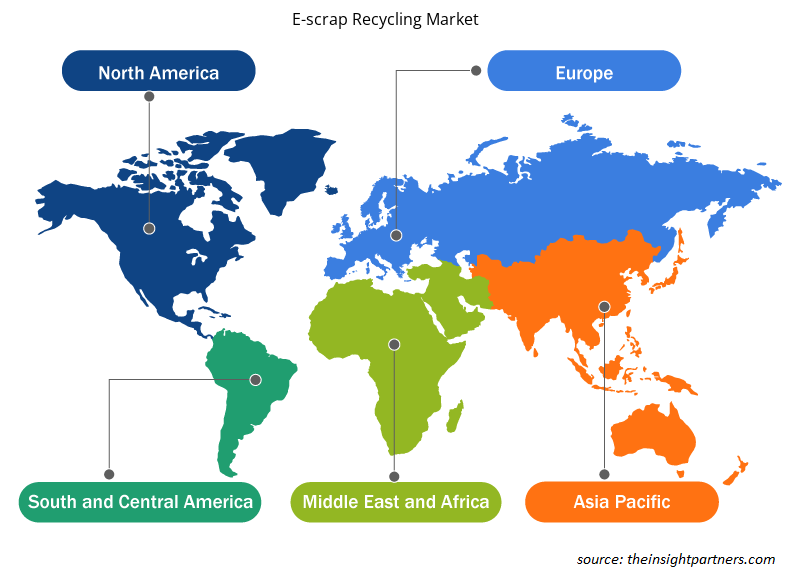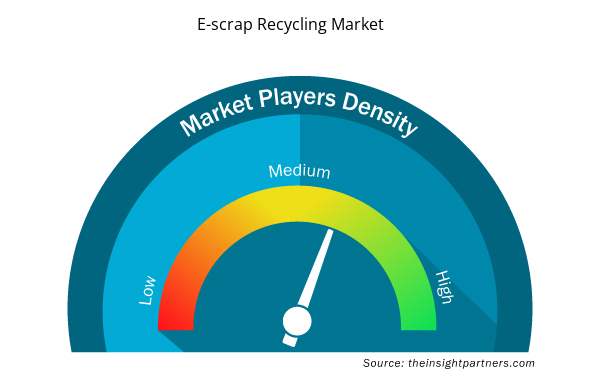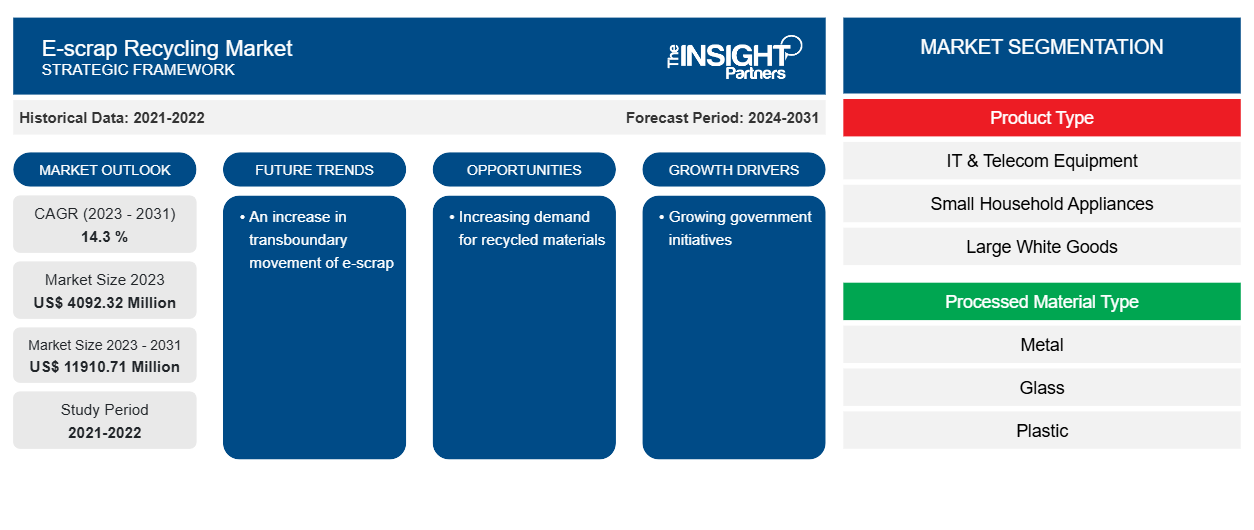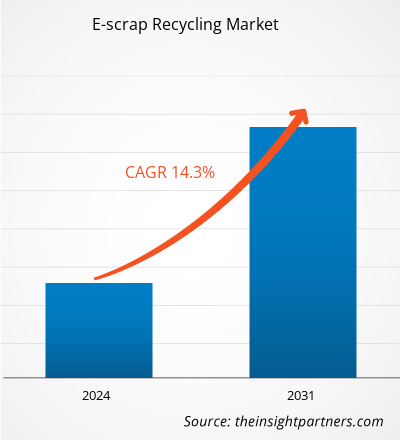Der Markt für das Recycling von Elektroschrott soll von 4092,32 Millionen US-Dollar im Jahr 2023 auf 11.910,71 Millionen US-Dollar im Jahr 2031 anwachsen. Der Markt soll zwischen 2023 und 2031 eine durchschnittliche jährliche Wachstumsrate von 14,3 % verzeichnen. Ein Anstieg des grenzüberschreitenden Transports von Elektroschrott dürfte ein wichtiger Trend auf dem Markt bleiben.
Marktanalyse für E-Schrott-Recycling
Hersteller von Haushaltsgeräten bieten auch neuere Modelle an, um Kunden anzulocken. Die Markteinführung neuer Produkte geht der Verschrottung der vorhandenen Haushaltsgeräte voraus , was den Akteuren auf dem Markt für Elektroschrottrecycling zugutekommt. Dies verändert die Elektroschrottrecyclingbranche erneut. Da der technologische Fortschritt weltweit rasant voranschreitet, müssen die Hersteller außerdem Verbraucherelektronik oder Haushaltsgeräte mit begrenzter Lebensdauer herstellen. Dies hilft den Herstellern, ihre Technologien im Laufe der Zeit zu verbessern, was zu einer Verringerung der Anzahl elektronischer Schrottplätze führt, was letztendlich den Markt für Elektroschrottrecycling antreibt.
Marktübersicht zum Recycling von Elektroschrott
Beim Recycling von Elektroschrott werden wertvolle Gegenstände gewonnen, indem der Elektroschrott in kleine Stücke zerlegt wird, die in einem neuen elektronischen Gerät recycelt werden können. Das Recycling von Elektroschrott hat viele Vorteile, darunter den Schutz der Umwelt und der menschlichen Gesundheit. Die meisten Materialien, aus denen Smartphones und Computer bestehen, bestehen aus nicht erneuerbaren Mineralien. Durch das Recycling dieser Materialien kann verhindert werden, dass die Versorgung mit Konsumgütern, die im Leben unverzichtbar sind, unterbrochen wird, bis Ersatz gefunden wird.
Passen Sie diesen Bericht Ihren Anforderungen an
Sie erhalten kostenlos individuelle Anpassungen an jedem Bericht, einschließlich Teilen dieses Berichts oder einer Analyse auf Länderebene, eines Excel-Datenpakets sowie tolle Angebote und Rabatte für Start-ups und Universitäten.
- Holen Sie sich die wichtigsten Markttrends aus diesem Bericht.Dieses KOSTENLOSE Beispiel umfasst eine Datenanalyse von Markttrends bis hin zu Schätzungen und Prognosen.
Treiber und Chancen auf dem Markt für E-Schrott-Recycling
Zunehmende Regierungsinitiativen
Die Regierungen verschiedener Länder ergreifen Initiativen zum Recycling von Elektroschrott. Die Regierung hat eine Reihe von Schritten unternommen, um den Recyclingsektor für Elektroschrott in den verschiedenen Ländern zu formalisieren. Die E-Waste (Management)-Regeln sehen eine obligatorische Genehmigung der Abbruch- und Recyclingeinheiten durch die beteiligten State Pollution Control Boards (SPCBs)/Pollution Control Committees (PCCs) vor. Das CPCB hat Richtlinien für die Verarbeitung von Elektroschrott herausgegeben. Das CPCB und die SPCBs haben die Einheiten beobachtet und mit Hilfe des Ministeriums für Elektronik und Informationstechnologie wurden die erforderlichen Maßnahmen ergriffen, um die Recyclingbranche zu verbessern und zu modernisieren. Daher treiben die wachsenden Regierungsinitiativen den Markt für das Recycling von Elektroschrott an.
Steigende Nachfrage nach recycelten Materialien
Verbraucher sind sehr zufrieden mit Produkten aus recycelten Materialien, die auch am Ende ihrer Lebensdauer ökologisch sind. In einer Umfrage unter einem Unternehmen ging eine große Mehrheit davon aus, dass Produkte aus recycelten Materialien denen aus Neumaterialien überlegen sind. Verbraucher weltweit sind zunehmend besorgt über Verpackungsmüll und die Freisetzung in die Umwelt, und die Regierungen haben begonnen, auf die öffentliche Meinung mit energischen Maßnahmen in beschleunigtem Zeitrahmen zu reagieren, sodass die Nachfrage nach recycelten Materialien steigt, was weitere Marktchancen schafft.
Segmentierungsanalyse des Marktberichts zum Recycling von Elektroschrott
Wichtige Segmente, die zur Ableitung der Marktanalyse zum Recycling von Elektroschrott beigetragen haben, sind Komponente, Protokoll und Anwendung.
- Basierend auf dem Produkttyp ist der Markt für das Recycling von Elektroschrott in IT- und Telekommunikationsgeräte, kleine Haushaltsgeräte, große Haushaltsgeräte, Unterhaltungselektronik und Sonstiges unterteilt. Das Segment IT- und Telekommunikationsgeräte hatte im Jahr 2023 einen größeren Marktanteil.
- Nach verarbeitetem Materialtyp ist der Markt in Metall, Glas, Kunststoff und Sonstiges segmentiert.
Marktanteilsanalyse für E-Schrott-Recycling nach geografischer Lage
Der geografische Umfang des Marktberichts zum Recycling von Elektroschrott ist hauptsächlich in fünf Regionen unterteilt: Nordamerika, Asien-Pazifik, Europa, Naher Osten und Afrika sowie Süd- und Mittelamerika.
Der APAC-Markt dominiert den E-Schrott-Recyclingmarkt. Verschiedene Faktoren treiben den E-Schrott-Recyclingmarkt im APAC-Raum an, wie wachsende Regierungsinitiativen, steigende Nachfrage nach recycelten Materialien und mehr. Daher wächst der Markt in der Region erheblich.
Regionale Einblicke in den Markt für E-Schrott-Recycling
Die regionalen Trends und Faktoren, die den Markt für E-Schrott-Recycling im Prognosezeitraum beeinflussen, wurden von den Analysten von Insight Partners ausführlich erläutert. In diesem Abschnitt werden auch die Marktsegmente und die Geografie des E-Schrott-Recyclings in Nordamerika, Europa, im asiatisch-pazifischen Raum, im Nahen Osten und Afrika sowie in Süd- und Mittelamerika erörtert.

- Erhalten Sie regionale Daten zum Markt für Elektroschrott-Recycling
Umfang des Marktberichts zum Recycling von Elektroschrott
| Berichtsattribut | Details |
|---|---|
| Marktgröße im Jahr 2023 | 4092,32 Millionen US-Dollar |
| Marktgröße bis 2031 | 11910,71 Millionen US-Dollar |
| Globale CAGR (2023 - 2031) | 14,3 % |
| Historische Daten | 2021-2022 |
| Prognosezeitraum | 2024–2031 |
| Abgedeckte Segmente | Nach Produkttyp
|
| Abgedeckte Regionen und Länder | Nordamerika
|
| Marktführer und wichtige Unternehmensprofile |
|
Marktteilnehmerdichte: Der Einfluss auf die Geschäftsdynamik
Der Markt für das Recycling von Elektroschrott wächst rasant. Dies wird durch die steigende Nachfrage der Endverbraucher aufgrund von Faktoren wie sich entwickelnden Verbraucherpräferenzen, technologischen Fortschritten und einem größeren Bewusstsein für die Vorteile des Produkts vorangetrieben. Mit der steigenden Nachfrage erweitern Unternehmen ihr Angebot, entwickeln Innovationen, um die Bedürfnisse der Verbraucher zu erfüllen, und nutzen neue Trends, was das Marktwachstum weiter ankurbelt.
Die Marktteilnehmerdichte bezieht sich auf die Verteilung von Firmen oder Unternehmen, die in einem bestimmten Markt oder einer bestimmten Branche tätig sind. Sie gibt an, wie viele Wettbewerber (Marktteilnehmer) in einem bestimmten Marktraum im Verhältnis zu seiner Größe oder seinem gesamten Marktwert präsent sind.
Die wichtigsten auf dem Markt für Elektroschrott-Recycling tätigen Unternehmen sind:
- DOWA HOLDINGS CO. LTD
- Ecoreco Ltd.
- Electronic Recyclers International Inc
- Enviro-Hub Holdings Ltd
- JX Nippon Mining & Metals Corporation
- Sims Metal Management Ltd
Haftungsausschluss : Die oben aufgeführten Unternehmen sind nicht in einer bestimmten Reihenfolge aufgeführt.

- Überblick über die wichtigsten Akteure auf dem Markt für Elektroschrott-Recycling
Neuigkeiten und aktuelle Entwicklungen zum Markt für E-Schrott-Recycling
Der Markt für E-Schrott-Recycling wird durch die Erhebung qualitativer und quantitativer Daten aus Primär- und Sekundärforschung bewertet, die wichtige Unternehmensveröffentlichungen, Verbandsdaten und Datenbanken umfasst. Nachfolgend sind einige der Entwicklungen auf dem Markt für E-Schrott-Recycling aufgeführt:
- Die Regierung wird in Kürze eine Online-Plattform einrichten, um den Handel mit Zertifikaten der erweiterten Herstellerverantwortung (Extended Producer Responsibility, EPR) zu erleichtern. Dieser Schritt wird dem Land helfen, die wachsende Plage des Elektroschrotts, wie etwa nicht mehr funktionierende Mobiltelefone und Laptops, zu bekämpfen. (Quelle: Extended Producer Responsibility (EPR), Pressemitteilung, März 2024.)
- Große Elektronikhersteller haben sich diese Woche mit der Consumer Technology Association zusammengeschlossen, um die Consumer Technology Circularity Initiative zu gründen, deren Ziel darin besteht, die Verarbeitung von Elektroschrott zu fördern, Reparatur und Wiederverwendung zu verbessern und mehr recycelte Materialien in Produkte einzubauen. (Quelle: Consumer Technology Association, Pressemitteilung, Januar 2024)
Marktbericht zum Recycling von Elektroschrott – Umfang und Ergebnisse
Der Bericht „Marktgröße und Prognose für das Recycling von Elektroschrott (2021–2031)“ bietet eine detaillierte Analyse des Marktes, die die folgenden Bereiche abdeckt:
- Marktgröße und Prognose für E-Schrott-Recycling auf globaler, regionaler und Länderebene für alle wichtigen Marktsegmente, die im Rahmen des Berichts abgedeckt sind
- Markttrends und Marktdynamiken für das Recycling von Elektroschrott wie Treiber, Hemmnisse und wichtige Chancen
- Detaillierte PEST/Porters Five Forces- und SWOT-Analyse
- Marktanalyse zum Recycling von Elektroschrott mit Blick auf wichtige Markttrends, globale und regionale Rahmenbedingungen, wichtige Akteure, Vorschriften und aktuelle Marktentwicklungen
- Branchenlandschaft und Wettbewerbsanalyse, einschließlich Marktkonzentration, Heatmap-Analyse, prominenten Akteuren und aktuellen Entwicklungen auf dem Markt für E-Schrott-Recycling
- Detaillierte Firmenprofile
- Historische Analyse (2 Jahre), Basisjahr, Prognose (7 Jahre) mit CAGR
- PEST- und SWOT-Analyse
- Marktgröße Wert/Volumen – Global, Regional, Land
- Branche und Wettbewerbsumfeld
- Excel-Datensatz



Report Coverage
Revenue forecast, Company Analysis, Industry landscape, Growth factors, and Trends

Segment Covered
This text is related
to segments covered.

Regional Scope
North America, Europe, Asia Pacific, Middle East & Africa, South & Central America

Country Scope
This text is related
to country scope.
Häufig gestellte Fragen
The expected CAGR of the global E-scrap recycling market is 14.3 %.
The global E-scrap recycling market is expected to reach US$ 11910.71 million by 2031.
An increase in transboundary movement of e-scrap is anticipated to play a significant role in the global E-scrap recycling market in the coming years.
The key players holding majority shares in the global E-scrap recycling market are DOWA HOLDINGS CO., LTD, Ecoreco Ltd, Electronic Recyclers International, Inc., Enviro-Hub Holdings Ltd, JX Nippon Mining & Metals Corporation, Sims Metal Management Ltd, Stena Metall Ab, Tetronics, Umicore, and Quantum Lifecycle Partners.
Growing government initiatives and increasing demand for recycled materials are the major factors that propel the global E-scrap recycling market.
APAC dominates the E-scrap recycling market.
The Insight Partners performs research in 4 major stages: Data Collection & Secondary Research, Primary Research, Data Analysis and Data Triangulation & Final Review.
- Data Collection and Secondary Research:
As a market research and consulting firm operating from a decade, we have published and advised several client across the globe. First step for any study will start with an assessment of currently available data and insights from existing reports. Further, historical and current market information is collected from Investor Presentations, Annual Reports, SEC Filings, etc., and other information related to company’s performance and market positioning are gathered from Paid Databases (Factiva, Hoovers, and Reuters) and various other publications available in public domain.
Several associations trade associates, technical forums, institutes, societies and organization are accessed to gain technical as well as market related insights through their publications such as research papers, blogs and press releases related to the studies are referred to get cues about the market. Further, white papers, journals, magazines, and other news articles published in last 3 years are scrutinized and analyzed to understand the current market trends.
- Primary Research:
The primarily interview analysis comprise of data obtained from industry participants interview and answers to survey questions gathered by in-house primary team.
For primary research, interviews are conducted with industry experts/CEOs/Marketing Managers/VPs/Subject Matter Experts from both demand and supply side to get a 360-degree view of the market. The primary team conducts several interviews based on the complexity of the markets to understand the various market trends and dynamics which makes research more credible and precise.
A typical research interview fulfils the following functions:
- Provides first-hand information on the market size, market trends, growth trends, competitive landscape, and outlook
- Validates and strengthens in-house secondary research findings
- Develops the analysis team’s expertise and market understanding
Primary research involves email interactions and telephone interviews for each market, category, segment, and sub-segment across geographies. The participants who typically take part in such a process include, but are not limited to:
- Industry participants: VPs, business development managers, market intelligence managers and national sales managers
- Outside experts: Valuation experts, research analysts and key opinion leaders specializing in the electronics and semiconductor industry.
Below is the breakup of our primary respondents by company, designation, and region:

Once we receive the confirmation from primary research sources or primary respondents, we finalize the base year market estimation and forecast the data as per the macroeconomic and microeconomic factors assessed during data collection.
- Data Analysis:
Once data is validated through both secondary as well as primary respondents, we finalize the market estimations by hypothesis formulation and factor analysis at regional and country level.
- Macro-Economic Factor Analysis:
We analyse macroeconomic indicators such the gross domestic product (GDP), increase in the demand for goods and services across industries, technological advancement, regional economic growth, governmental policies, the influence of COVID-19, PEST analysis, and other aspects. This analysis aids in setting benchmarks for various nations/regions and approximating market splits. Additionally, the general trend of the aforementioned components aid in determining the market's development possibilities.
- Country Level Data:
Various factors that are especially aligned to the country are taken into account to determine the market size for a certain area and country, including the presence of vendors, such as headquarters and offices, the country's GDP, demand patterns, and industry growth. To comprehend the market dynamics for the nation, a number of growth variables, inhibitors, application areas, and current market trends are researched. The aforementioned elements aid in determining the country's overall market's growth potential.
- Company Profile:
The “Table of Contents” is formulated by listing and analyzing more than 25 - 30 companies operating in the market ecosystem across geographies. However, we profile only 10 companies as a standard practice in our syndicate reports. These 10 companies comprise leading, emerging, and regional players. Nonetheless, our analysis is not restricted to the 10 listed companies, we also analyze other companies present in the market to develop a holistic view and understand the prevailing trends. The “Company Profiles” section in the report covers key facts, business description, products & services, financial information, SWOT analysis, and key developments. The financial information presented is extracted from the annual reports and official documents of the publicly listed companies. Upon collecting the information for the sections of respective companies, we verify them via various primary sources and then compile the data in respective company profiles. The company level information helps us in deriving the base number as well as in forecasting the market size.
- Developing Base Number:
Aggregation of sales statistics (2020-2022) and macro-economic factor, and other secondary and primary research insights are utilized to arrive at base number and related market shares for 2022. The data gaps are identified in this step and relevant market data is analyzed, collected from paid primary interviews or databases. On finalizing the base year market size, forecasts are developed on the basis of macro-economic, industry and market growth factors and company level analysis.
- Data Triangulation and Final Review:
The market findings and base year market size calculations are validated from supply as well as demand side. Demand side validations are based on macro-economic factor analysis and benchmarks for respective regions and countries. In case of supply side validations, revenues of major companies are estimated (in case not available) based on industry benchmark, approximate number of employees, product portfolio, and primary interviews revenues are gathered. Further revenue from target product/service segment is assessed to avoid overshooting of market statistics. In case of heavy deviations between supply and demand side values, all thes steps are repeated to achieve synchronization.
We follow an iterative model, wherein we share our research findings with Subject Matter Experts (SME’s) and Key Opinion Leaders (KOLs) until consensus view of the market is not formulated – this model negates any drastic deviation in the opinions of experts. Only validated and universally acceptable research findings are quoted in our reports.
We have important check points that we use to validate our research findings – which we call – data triangulation, where we validate the information, we generate from secondary sources with primary interviews and then we re-validate with our internal data bases and Subject matter experts. This comprehensive model enables us to deliver high quality, reliable data in shortest possible time.


 Holen Sie sich ein kostenloses Muster für diesen Bericht
Holen Sie sich ein kostenloses Muster für diesen Bericht